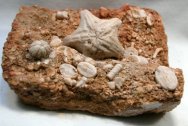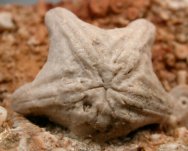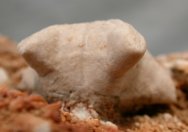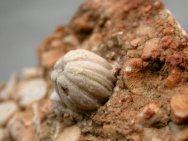Name: Echinodermata,
Class Blastodea, Orophocrinus stelliformis, Cryptoblastus melo
Age: Lower
Mississippian Middle Osagean Stage (345 m.y.a)
Size: mm
(25.4mm=1 inch): Orophocrinus: 15 mm by 35 mm, Cryptoblastus: 9 mm by
10 mm on a 65 by 85 mm matrix
Location:
Burlington Formation, Pike County, Missouri
| 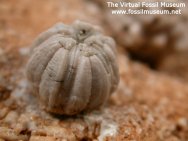 Description:
Well-preserved example of an unusual spiraculate blastoid known
as Orophocrinus stelliformis. It is easy to see where the species
derives its name, with its starlike shape. These are hard to find
intact, and highly prized by collectors. It is accompanied by an
example of the spiraculate blastoids, a close relative of the crinoids,
known as Cryptoblastus. The Burlington Formation is as much as 50
m in thickness, and covers a large portion of Missouri as well as
Iowa and Illinois along the Mississippi River. It is composed largely
of undolomitzied crinoidal limestone. The sediment was an unconsolidated,
coarse-grained, and poorly sorted sand to gravel substratum which
was episodically mobile. Such a substrate was not suitable for Description:
Well-preserved example of an unusual spiraculate blastoid known
as Orophocrinus stelliformis. It is easy to see where the species
derives its name, with its starlike shape. These are hard to find
intact, and highly prized by collectors. It is accompanied by an
example of the spiraculate blastoids, a close relative of the crinoids,
known as Cryptoblastus. The Burlington Formation is as much as 50
m in thickness, and covers a large portion of Missouri as well as
Iowa and Illinois along the Mississippi River. It is composed largely
of undolomitzied crinoidal limestone. The sediment was an unconsolidated,
coarse-grained, and poorly sorted sand to gravel substratum which
was episodically mobile. Such a substrate was not suitable for  brachiopods,
bryozoans, or corals, but was apparently ideal for the many types
of camerate crinoids that have been found. While the material was
episodically disturbed by storms, the rigidly- sutured calyx of
camerate crinoids were ideally suited to preservation. Few are found
with attached arms or stems, but many parts are also found with
the crowns in the “hash” that was preserved. It was
also a suitable home for blastoids; indeed, some 20% of the known
fossil blastoid taxa are known from the Burlington Formation. Here
are 2 of the diverse forms preserved in this wonderful deposit,
with the white blastoids a stark contrast to the orange-brown matrix.
Notice the many crionoid stem fragments present as well, a reminder
of the diverse Echinoderms found. brachiopods,
bryozoans, or corals, but was apparently ideal for the many types
of camerate crinoids that have been found. While the material was
episodically disturbed by storms, the rigidly- sutured calyx of
camerate crinoids were ideally suited to preservation. Few are found
with attached arms or stems, but many parts are also found with
the crowns in the “hash” that was preserved. It was
also a suitable home for blastoids; indeed, some 20% of the known
fossil blastoid taxa are known from the Burlington Formation. Here
are 2 of the diverse forms preserved in this wonderful deposit,
with the white blastoids a stark contrast to the orange-brown matrix.
Notice the many crionoid stem fragments present as well, a reminder
of the diverse Echinoderms found.
|
|



